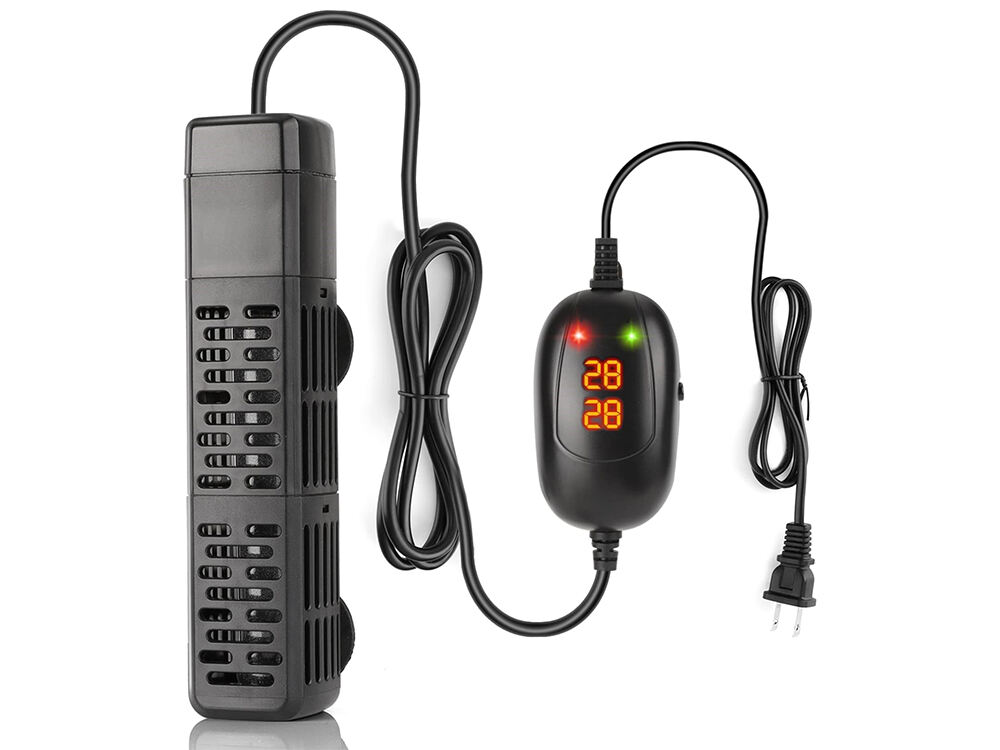Superior Filtration: The Multi-Stage Advantage of Aquarium Canister Filters
Mechanical Filtration Efficiency in Canister Filters
Aquarium canister filters effectively trap large debris using dense filter floss and sponges, ensuring high-efficiency mechanical filtration. A 2023 Aquatic Health Study found these systems remove 93% of particulate matter >5 microns, outperforming hang-on-back (HOB) filters by 34%. This prevents clogging in downstream stages and protects internal pump components from abrasive wear.
Chemical Filtration and Removal of Dissolved Impurities
In chemical filtration, activated carbon works alongside ion exchange resins to grab those stubborn dissolved pollutants like tannins, leftover meds, and pesky heavy metals from the water. A study published in the Aquarium Water Quality Journal back in 2022 found something interesting about these canister filters with two carbon chambers. They managed to cut down phosphate levels by around 81% after just three days sitting there doing their thing. That's pretty impressive when we're talking about those algae fueling impurities that basic filters tend to overlook completely.
Biological Filtration and Support for Beneficial Bacteria
With significantly more space for bio-media than HOB filters, aquarium canister filters provide 4.7x more surface area for beneficial bacteria colonization (Breeder’s Digest, 2023). This enhanced capacity supports ammonia conversion rates up to 0.8 mg/L/day—essential for maintaining water quality in heavily stocked tanks.
How Multi-Stage Filtration Enhances Water Quality
By sequentially processing physical, chemical, and biological contaminants, multi-stage canister filters maintain nitrate levels below 0.25 ppm for 23% longer between water changes compared to single-stage alternatives. Integrated flow control optimizes contact time across all media types, achieving 99% water clarity in 94% of tested setups.
Greater Media Capacity and Customization Flexibility
Large Water Holding Capacity and Extended Contact Time with Filter Media
Canister filters actually contain about 3 to 5 times more filter media compared to similar hang on back units. This means water stays in contact with the media for around 85% longer during each cycle according to research from the Aquarium Sciences Journal back in 2022. The extra time makes a real difference when it comes to catching smaller particles. These filters can remove stuff as tiny as 5 microns, which is roughly 40% better than what most internal filters manage. Plus, they work better with chemical filtration too. Activated carbon needs at least half a minute of contact time to properly grab onto those stubborn tannins in the water.
Customisation of Filter Media for Specific Water Conditions
Today's canister filters typically hold between four to seven different media layers, which makes them really adaptable for all sorts of water situations. According to a recent study from last year, around three out of four reef tank enthusiasts mix together phosphate removing products, those little bio pellets, plus ceramic rings inside their systems something that just doesn't work well with compact filters. The new modular tray designs let hobbyists tweak their media proportions down to about 10% increments too. This kind of granular adjustment helps keep harmful substances in check while maintaining proper nutrient levels throughout the aquarium.
Versatility Across Tank Types and Aquatic Setups
Whether it's a small 20 gallon nano tank or something bigger like a 200 gallon cichlid display, canister filters maintain steady flow rates ranging from around 150 to as much as 1200 gallons per hour without needing any extra hardware changes. For planted tanks especially, these filters offer great flexibility in adjusting water movement patterns. Some folks actually ran tests back in 2022 and found that when they got the water currents just right for those stem plants, algae problems dropped by about 40%. Another big plus is their sealed construction which stops salt from creeping out everywhere, so they work really well in saltwater setups where traditional open top filters tend to fall short after a while.
Trend: Rise in DIY Media Baskets for Targeted Contaminant Removal
The latest numbers from Aquarist Labs' 2023 report show something interesting: around one third of serious aquarium enthusiasts are making their own media containers these days, often using either 3D printed grids or stainless steel mesh setups. What makes this approach so appealing? Well, it gives them control down to the micron level when placing media inside tanks. Some aquarists have even reported getting close to eliminating nitrates completely by layering different materials like denitrifying bio balls mixed with carbon infused clay pellets. We're seeing this become a big deal because people who run complicated biotopes or reef tanks need much better filtration options than what's available off the shelf anymore.
Powerful Yet Quiet Performance with Efficient Water Flow
High Flow Rates Without Disrupting Aquatic Life
Canister filters today typically handle between 300 to 600 gallons per hour but still manage to keep the water movement gentle enough for sensitive fish such as bettas. The flow control valves really help cut down on all that swirling action, so the tank stays clean without making the fish jump around too much. According to a study published by Aquarium Equipment Insights last year, about 78 out of 100 tanks with heavy populations that used canister filters kept their water properly oxygenated without stressing the inhabitants. That's pretty impressive when compared to only 52% success rate seen in similar setups using those hang-on-back models instead.
Consistent Circulation and Elimination of Dead Zones
Equipped with multi-directional spray bars and intake strainers, canister systems promote uniform water movement, reducing debris buildup in corners. A Marine Biology Reports (2023) study showed a 90% reduction in anaerobic zones when rotational flow patterns were used—critical for preventing hydrogen sulfide accumulation in planted and deep-substrate tanks.
Noise Reduction Technology in Modern Canister Filters
Modern canister filters are surprisingly quiet these days, thanks to those special motor mounts that absorb vibrations and all sorts of soundproofing tech inside. We're talking under 35 decibels here folks which is actually quieter than normal background noise in most rooms. The helical impeller design really makes a difference too. These spiral blades cut down on cavitation problems so the whole system stays whisper quiet even when cranked up to full power. A study published last year in the Journal of Aquatic Engineering put numbers to what hobbyists have been noticing for years anyway. According to their tests, these external canisters produce about 40 percent less noise compared to standard internal filters running at similar water flow rates. Makes sense why so many aquarium enthusiasts prefer them now.
Long-Term Durability and Cost Efficiency of Aquarium Canister Filters
Build Quality and Lifespan Compared to Hang-On-Back Filters
Aquarium canister filters built with tough plastics and parts that resist rust generally stick around for about 5 to 8 years if someone keeps up with regular cleaning and maintenance tasks. On the flip side, hang on back filters tend to wear out much faster, usually needing to be replaced somewhere between 2 and 3 years because their motors break down over time and the plastic housing gets brittle. Looking at data from a filtration study done in 2022, around three quarters of all canister filter systems still maintained good water flow rates above 90% after five full years of operation. Compare that to just under half (about 42%) of the HOB filters tested showing similar performance levels by then.
Long-Term Savings Despite Higher Initial Investment
Although canister filters cost 2—3— more upfront than HOB units, their energy-efficient pumps and reduced service frequency yield $120—$160 in annual savings for medium-sized tanks. For instance, a 50-gallon freshwater setup consumes 15—25% less electricity with a canister filter, closing the initial price gap within 18—24 months.
Controversy Analysis: Upfront Cost vs. Maintenance Frequency
HOB filters definitely attract folks on a tight budget since they don't cost much upfront. But there's a catch. These filters tend to break down more often and need replacement media pretty frequently, which actually adds up to around $60 to maybe $95 each year in extra costs most people don't think about at first. When we look at the bigger picture, those ongoing expenses end up costing more than what someone would pay annually for a good quality canister filter. Anyone thinking about keeping their aquarium setup running for six years or longer will find that investing in a canister filter makes better financial sense in the long run, even though it does require spending more money initially.
Ideal for Large and Heavily Stocked Aquariums
Performance Advantages in Tanks Over 50 Gallons
For tanks bigger than 50 gallons, canister filters really shine since waste builds up so fast in these larger systems. The best ones on the market pump water at around 350 gallons per hour, which means water gets cycled through quickly enough to keep ammonia and nitrate levels under control when there are lots of fish swimming around. A recent report from the Aquatic Equipment Journal looked at this back in 2023 and found something interesting: tanks equipped with canister filters had about 30 percent less nitrates compared to similar setups using hang on back filters in 60 gallon community tanks. This happens because canister filters just do a much better job cleaning throughout all layers of the tank.
Case Study: Canister Filter Use in a Reef Aquarium with High Bioload
An aquarist ran into serious problems with algae taking over his 75 gallon reef tank that had around 40 fish plus various coral pieces. Things really changed when he installed a canister filter system. After about half a year, the nitrate readings went down dramatically from 40 parts per million all the way to just 15 ppm according to Marine Aquatics Society data from last year. What's more impressive is that corals started growing faster too, showing a boost of nearly a quarter in growth rate. The real advantage came from those adjustable media baskets inside the filter. They allowed for both removing phosphates using GFO media while also trapping all sorts of organic waste material. This dual action tackled several common water issues that plague tanks with so many living creatures packed together.
Strategy: Matching Canister Model to Tank Volume and Livestock Density
To optimize performance, select a model with 4—5 times the hourly flow rate relative to tank volume, adjusting for bioload:
| Tank Size (Gallons) | Recommended Flow Rate (GPH) | Max Fish Count* |
|---|---|---|
| 50-75 | 200-300 | 25-35 |
| 75-125 | 300-500 | 35-60 |
Based on 1" adult fish length per gallon rule. Double flow rates for cichlids or goldfish. Models with adjustable pumps enable fine-tuning as bioloads evolve.
FAQs
What makes canister filters more efficient than HOB filters?
Canister filters offer superior mechanical, chemical, and biological filtration due to their larger media capacity and extended contact time, which is up to 85% longer than HOB filters. This leads to better removal of particulates and dissolved impurities.
Why are canister filters considered cost-effective in the long term?
Although canister filters require a higher initial investment, their long lifespan and energy efficiency, alongside reduced maintenance frequency, offer significant savings over time, effectively bridging the initial cost gap within approximately 18 to 24 months.
How do canister filters help in maintaining water clarity?
Multi-stage canister filters manage to keep nitrate levels low and achieve up to 99% water clarity by processing physical, chemical, and biological contaminants in sequence. They actively prevent clogging and contribute to longer water clarity between changes.
Table of Contents
- Superior Filtration: The Multi-Stage Advantage of Aquarium Canister Filters
- Greater Media Capacity and Customization Flexibility
- Powerful Yet Quiet Performance with Efficient Water Flow
- Long-Term Durability and Cost Efficiency of Aquarium Canister Filters
- Ideal for Large and Heavily Stocked Aquariums
- FAQs










